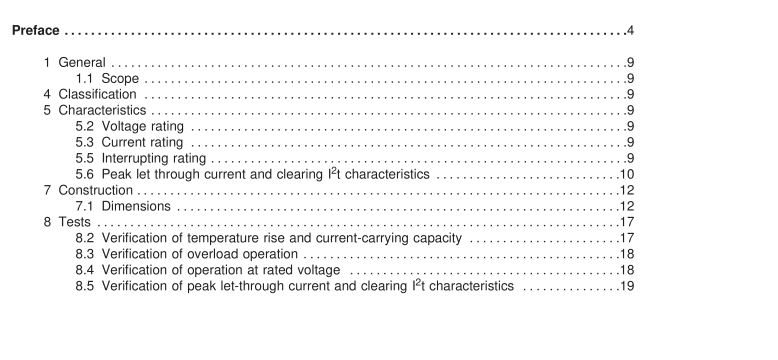UL 248-15-2010 pdf download.Low-Voltage Fuses – Part 1 5: Class T Fuses.
1 General NOTE – This Part is intended to be read together with the Standard for Low-Voltage Fuses – Part 1 : General Requirements, hereafter referred to as Part 1 . The numbering of the Clauses in this Part corresponds to like numbered Clauses in Part 1 . The requirements of Part 1 apply unless modified by this Part. For Clauses not shown below, refer to the Standard for Low-Voltage Fuses – Part 1 : General Requirements, NMX-J-009/248/1 5-2000-ANCE ♦ CAN/CSA C22.2 No. 248.1 ♦ UL 248-1 . 1.1 Scope This Part applies to Class T fuses rated 1 200 A or less and 300 or 600 V ac. DC ratings are optional. 4 Classification Class T fuses are non-renewable and current limiting with an interrupting rating of 200,000 A. Each of the voltage ratins, 300 and 600 V ac, is divided into eight body sizes. The maximum current rating I n for each size is specified in this Part. Time-delay ratings are optional. 5 Characteristics 5.2 Voltage rating For AC, the rating shall be 300 V ac or 600 V ac in accordance with dimensions shown in Figures A and B. The DC voltage rating may be different from the AC rating. 5.3 Current rating Refer to Figure A for range of current ratings in each body size for each voltage rating. 5.5 Interrupting rating For AC – 200,000 A For DC, the preferred ratings are 1 0,000, 20,000, 50,000, 1 00,000, 1 50,000, or 200,000 A
8 Tests 8.2 Verification of temperature rise and current-carrying capacity 8.2.3 Test method Fuses rated 0 – 600 A: 1 .0 I n – Temperature rise 1 .1 I n – Current-carrying capacity, I nf Fuses rated 601 – 1 200 A: 1 .0 I n – Temperature rise and current-carrying capacity, I nf 8.2.3.1 In addition to the requirements in Part 1 : At the conclusion of the temperature rise test, the test current shall be increased without interruption to 1 .1 I n for a period of not less than 1 5 min for fuses rated 0 – 200 A and not less than 30 min for fuses rated 201 – 600 A. Temperature is not to be monitored during this time.
8.2.4 Acceptability of test results The maximum temperature rise shall not exceed the following: Contacts 0 to 1 00 A – 55°C 1 01 to 600 A – 75°C 601 to 1 200 A – 75°C above equipment calibration temperature 8.3 Verification of overload operation Part 1 , Table 4 Test 1 – 1 .35 I n (Fuses rated 0 – 600 A) Test 2 – 1 .5 I n (Fuses rated 601 – 1 200 A) Test 3 – 2.0 I n (Fuses rated 0 – 600 A) Test 5 – 5.0 I n for time-delay fuses only 8.4 Verification of operation at rated voltage For AC – Part 1 , Table 5 Test 1 – 200 kA Test 2 – Maximum energy Test 3 – Threshold ratio. The maximum threshold ratio shall be 30. Test 4a – 1 00 kA Test 4b – 50 kA Test 5a – 3.0 I n (Fuses rated 601 – 1 200 A) Test 5b – 2.01 I n (Fuses rated 0 – 600 A) Peak let-through current and clearing I 2 t recorded during Tests 1 , 4a, and 4b. For DC (optional) – Part 1 , Table 6 Test 1 – Interrupting Rating
Fuses rated 0 – 600 A: Test 2 – Maximum energy Test 5a – 9.0 I n for time-delay fuses only Test 5c – 2.0 I n Fuses rated 601 – 1 200 A: Test 5b – (3.0 I n ) or Test 5c – (2.0 I n ) or Any current in the range 3.0 I n – 2.0 I n at rated DC voltage 8.5 Verification of peak let-through current and clearing I 2 t characteristics 8.5.3 Acceptability of test results In addition to the requirements in Part 1 : Peak let-through current and clearing I 2 t values recorded shall not exceed the specified limits in Tables A and B.UL 248-15-2010 pdf download.
UL 248-15-2010 pdf download
